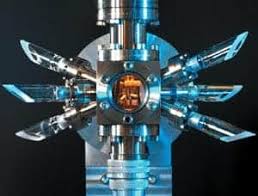Optical Atomic Clock:

An international team of 65 scientists successfully conducted the largest optical clock comparison across three continents, paving the way to redefine the SI unit of time the second using optical atomic clocks.
- An optical atomic clock is a next-generation timekeeping device that uses light waves from atoms (in the optical frequency range) instead of microwaves (as in caesium clocks) to measure time with ultra-high precision.
- Materials Used: Strontium-87 (Sr), Ytterbium-171 (Yb), Ytterbium ions (Yb⁺ E2, Yb⁺ E3), Strontium, 88 ions (Sr⁺), and Indium-115 ions (In⁺).
- These atoms and ions are chosen for their stable electronic transitions, critical for accurate frequency measurement.
- Objective of Optical Clocks:
- To replace caesium-based atomic clocks as the new international standard for defining the second.
- To support high-precision applications in GPS, climate science, space navigation, and radio astronomy.
- To improve global time synchronization with enhanced stability and reliability.




